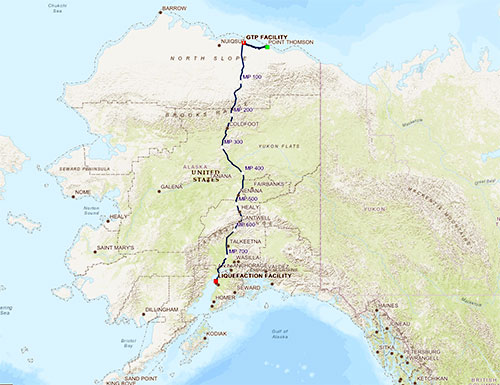
Alaska LNG Project clears a significant regulatory hurdleBy MARY KAUFFMAN
March 09, 2020
The Federal Energy Regulatory Commission staff prepared the final environmental impact statement (EIS) to assess the impacts of constructing and operating the Alaska LNG Project proposed by the Alaska Gasline Development Corporation, an independent, public corporation of the State of Alaska. The purpose of the Alaska LNG Project is to commercialize the natural gas resources of Alaska’s North Slope by converting the existing natural gas supply to liquefied natural gas (LNG) for export and providing gas for users in Alaska.
The Alaska Gasline Development Corporation (AGDC) has been seeking the authorization to construct, own, and operate in Alaska: a new Gas Treatment Plant; a 1.0-mile-long, 60-inch-diameter Prudhoe Bay Unit Gas Transmission Line; a 62.5-mile-long, 32-inch-diameter Point Thomson Unit Gas Transmission Line; an 806.9-mile-long, 42-inch-diameter natural gas pipeline (Mainline Pipeline) and associated aboveground facilities, including eight compressor stations and a heater station; and a 20 million metric-ton per annum liquefaction facility (Liquefaction Facilities), including an LNG Plant and Marine Terminal Facilities. Quoting a news release from the Alaska House Majority, the Alaska LNG is a longstanding effort of the State of Alaska and industry partners to commercialize the North Slope’s vast natural gas reserves, something the project would achieve with an 807-mile, 42-inch pipeline and a new gas treatment plant. The EIS reflects six years of public input, engineering, science-based environmental research, and cultural resource studies which assesses more than 150,000 pages of data. The House Resources Committee co-chairs released a joint statement on Friday’s news, Reps. Geran Tarr (D-Anchorage) and John Lincoln (I-Kotzebue) said, “There is a long way to go before Alaskans will finally enjoy the benefits of commercialized North Slope gas. Today’s development, however, is a major regulatory milestone that is the culmination of significant private and public investment over the past several years. We applaud the hard work and collaboration that went into this achievement and hope that we will receive good news this summer about the viability of Alaska LNG.” Alaska State Senators also commended the state corporation for its 6-plus years of diligent work in achieving the Final Environmental Impact Statement (FEIS) from the Federal Energy Regulatory Commission (FERC). “This significant milestone is the product of hard-working Alaskans, with strong input from Alaskans statewide,” said Senate President Cathy Giessel (R-Anchorage). Giessel said, “The LNG project has tremendous potential to generate new revenue and jobs for our state, and we’re encouraged by this progress. The FEIS is not a final green light for this project, but paves the way for the actual authorization expected in June. I appreciate the hard work that AGDC and our industry partners, BP and ExxonMobil, have done to reduce the cost of the project.” The several thousand-page FEIS provides conditions for project construction that protect important Alaskan environmental and cultural assets. A clear understanding of federal conditions for the $43 billion project will also help AGDC attract partners and investors, according an Alaska Senate Majority news release. “Hats off to the many Alaskans, from community members to AGDC and our project partners involved with helping us reach this significant FEIS accomplishment,” said Senator Peter Micciche (R-Soldotna), chairman of the Senate Resources Committee. Micciche said, “Reducing risk is key to attracting capital for this potentially course-changing project, and to ensuring a project that ultimately generates revenue to the state and energy and jobs for Alaskans. Once we have the final approval from federal regulators, expected later this year, Alaskans will know the true marketplace potential for this monumental LNG export project.” The Center for Biological Diversity reacted to the release of the final EIS for the Alaska LNG Project which they say will export fracked gas from Alaska to Asia. The proposal calls for an 807-mile pipeline, a facility to liquefy natural gas, and the shipping of about 20 million tons of the condensed fuel abroad annually. The pipeline would have a daily capacity of 3.9 billion cubic feet of natural gas, which could result in more than 90 million tons of carbon dioxide equivalent emissions annually according to the Center for Biological Diversity opposed to the project. That’s the same global warming impact as operating 21 coal-fired power plants. “This study confirms that the Alaska LNG Project would harm Alaska’s endangered wildlife and its rapidly warming environment. It’s time to abandon this terrible idea once and for all,” said Kristen Monsell, a senior attorney with the Center for Biological Diversity. Monsell said, “Building a gas pipeline across Alaska’s thawing permafrost is a risky move that would worsen the climate crisis. Asia would get cheap American fossil fuel while polar bears, whales and Alaskans would pay a heavy price.” The proposal originally involved BP, ConocoPhillips, ExxonMobil and the state-owned Alaska Gasline Development Corporation. The oil companies pulled out of the project several years ago because of the surplus LNG at that time on the world market and the project's high cost, currently estimated at $45 billion, which could leave Alaska taxpayers on the hook if LNG prices stayed low. Alaska's Gasline Development Corporation, the only party currently pursuing the project, submitted its application to FERC on April 17, 2017. Former Governor Bill Walker asked the Trump administration to fast-track approval and exempt the project from dozens of environmental rules. The Federal Regulatory Commission concluded: "The Project would result in positive impacts on the state and local economies, but adverse impacts on housing, population, public services, and local businesses could occur in some areas during construction. The Project could disproportionately affect environmental justice communities due to impacts on subsistence practices and public health effects based on a Health Impact Assessment prepared by AGDC, but these impacts are not expected to be high and adverse." Other conclusions by the Federal Regulatory Commission:
On the Web:
Source of News:
|
||||
